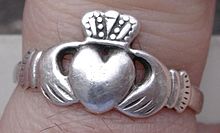Claddagh ring
The Claddagh ring is a finger ring that originated in the Irish fishing village of Claddagh near Galway ( County Galway ). The ring shows two hands holding a heart with a crown. The heart symbolizes love, the hands friendship (trust) and the crown fidelity (loyalty).
Since the late 20th century, the Claddagh ring has also enjoyed great popularity outside of Claddagh and Ireland .
The legend
Claddagh is a small fishing village in western Ireland (now a suburb of Galway), and was where Richard Joyce lived from about 1660 to 1737. Shortly before his planned wedding he was kidnapped by Algerian pirates as a fisherman or traveling salesman (the legend is not fixed) and sold as a slave to a Moorish goldsmith . He quickly learned his master's craft and brought it to perfection. His masterpiece was a ring that he created longing for his distant fiancée and that would later be referred to as the Claddagh ring. The symbol, processed as a ring, shows two hands holding a heart and a crown hovers above it.
Richard was lucky that William III. in 1689, shortly after his accession to the throne, he was able to conclude an agreement with the Moors, which made it possible for all British imprisoned there to return. Although his former master offered him his daughter and a business share for his stay, Richard returned to his home in Claddagh and there actually found his bride unmarried and waiting.
Even if - as with all legends - there are considerable doubts as to its correctness, there are several facts in favor of it: The oldest existing Claddagh rings are signed RI, and a jeweler named Richard Ioyes (Gaelic for Joyce) is considered to be proven. The signature also shows an anchor , the symbol of hope.
The symbolism
Claddagh rings are used, among other things, as friendship or engagement or wedding rings .
- If it is worn on the right hand and the tip of the heart points away from the wearer (i.e. towards the fingertips), it signals the search for a partner.
- Worn on the right, with the heart pointing towards the wearer, it is announced that a love connection already exists.
- The ring on the left hand and the tip of the heart facing the wearer corresponds to a wedding ring.
It was probably perfectionists who later had to create a meaning for the fourth type of wearing (left, heart pointing away from the wearer): It is about someone divorced. Other sources say that wearing this indicates an engagement. It should be noted, however, that in Germany and Austria it is customary to wear the wedding ring on the right ring finger; insofar the above is true in this country. Symbolism not necessarily.
Traditionally, a Claddagh ring is passed on from mother to daughter or from grandmother to granddaughter through generations.
Other explanations
It is often assumed that the Claddagh ring is older than the date given in the most popular legend at the end of the 17th century.
In the oldest version, Celtic mythology is used. The crown symbolizes Beathauile; the left hand represents Manu, who is considered the mother of the Gaelic people. The right hand is Dagda Mór, the mighty father of gods. The heart represents humanity.
A more practical explanation sees the Claddagh symbol as a kind of seal of the fishermen in this region . It wasn't just painted on ships and sails; every fisherman had to carry it with him as a sign of his authorization as a ring. If a fishing boat was picked up whose crew could not produce a Claddagh ring, they were classified as intruders and quickly liquidated. This interpretation does not find very many supporters today.
The church has also claimed the Claddagh symbol for itself, with two explanations: firstly with love, friendship and loyalty as Jesus' attributes and secondly as a symbol of the Trinity (crown and 2 hands) which humanity (the heart ) protected.
Another interpretation is very credible: starting from the rulers of the region around Claddagh (there were even kings of fishermen there - The Fishing Kings Of Galway), it is supposed to express the motto of the potentates: “We want to rule in love and friendship . "
This interpretation is supported by the fact that some English kings / queens, such as Victoria and Edward VII, wore the Claddagh ring.
There is also a Dublin version of the Claddagh symbol with two hands and two hearts, but without a crown. She became known as Fenian Claddagh.
In the media
- The motif is partly used as a logo by the Scottish band Simple Minds . It prominently graces the cover of the 1987 album Live in the City of Light , as well as other publications such as The Best of Simple Minds or Graffiti Soul .
- Occurrence in TV series and films:
- In the television series Buffy the Vampire Slayer , Angel, who is originally from Ireland, gives Buffy such a ring.
- On the US reality show All My Wives , Kody Brown and his wives wear a Claddagh ring (season 1, episode 6 and 7).
- A Claddagh ring is featured in the 2011 film Kill the Irishman .
Web links
- Former website: Claddagh at Claddagh.com in Ireland. ( Memento from February 20, 2008 in the Internet Archive )

